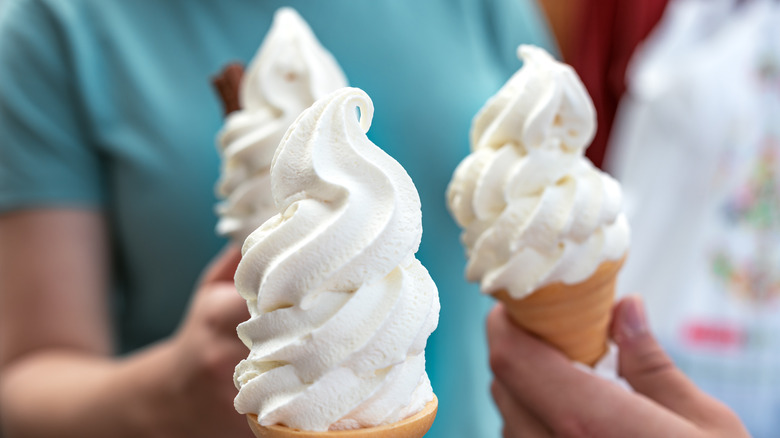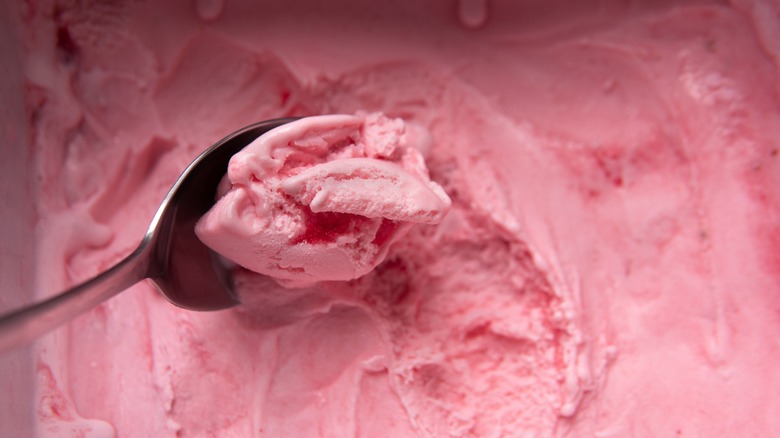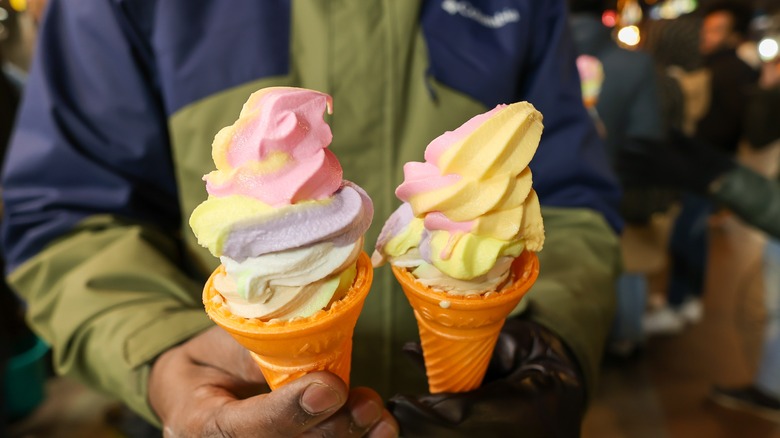The Differences Between Soft Serve And Custard, Explained
Ah, summer. It's the season of sun, fun, the best summer desserts, and the eternal debate: soft serve or custard? We've all heard about the age-old soft serve vs. ice cream discussion or the assumption that frozen yogurt is better for you than soft serve, but not much light has been shed on the differences between the airy sweet treat that is soft serve and the rich custard we all know and love.
But what really sets them apart? Is it just about creaminess, or is there a scoop of science behind it? Are we making much ado about nothing, or is the distinction truly worth the delicious dilemma? And why, oh why, are there so many misconceptions swirling around, like our favorite toppings on a sundae?
Whether you're crafting an epic sundae, searching for the ideal base for toppings, or seeking the perfect solo flavor experience, diving into the differences helps ensure every lick and spoonful is a choice made with delightful intention. As we've found ourselves once again staring confounded at a menu board, let's unravel the delectable differences between soft serve and custard.
What is soft serve?
More than the iconic silky swirls we love to watch pile high on a cone, soft serve is childhood nostalgia: a sweltering summer day, the sun overhead, and your favorite ice cream cone staving off the afternoon with frozen delight — moments with soft serve ice cream become unforgettable and almost magical.
Accidentally invented in the U.S. in 1934 (thanks to a serendipitous ice cream truck breakdown), soft serve began as literal melting ice cream being rushedly sold to passersby — and everyone's aware of how successful that became! Now, soft served ice cream is prevalent not just in ice cream trucks, but everywhere, offering a fluffier and less dense texture compared to traditional ice cream.
Soft serve ice cream is typically made from seven main components: milk fat, milk solids, sugars, stabilizers, emulsifiers, water, and flavor additives. But what truly makes soft serve stand out is how it's dispensed in a continuous swirl, giving it that iconic twisty top. Whether it's vanilla or strawberry, dipped in chocolate or sprinkles, in quirky cones or a cup, soft serve is a creamy, dreamy treat that never fails to bring out the inner child in us.
What is custard?
Close your eyes and imagine a decadent, luscious treat that's almost like the love child of traditional ice cream and gelato. Originally from Coney Island, New York in the 1910s, this delightful dessert is made with a base of milk, cream, and sugar, just like ice cream. But here's the twist: it also contains egg yolks! The pair of ice cream sellers who invented the dessert discovered that incorporating egg yolks improved the creaminess of their ice cream and extended its cold retention. So it's these yolks that make all the difference, imparting that extra velvety texture that has made custard a beloved treat for many.
But more than the standard ingredients and the addition of eggs, other ingredients like extracts, fruit, and flavorings like chocolate can be added to frozen custard for enhanced sweetness and taste, making them a very versatile base for your desserts. While thinking of custard as ice cream's egg-y cousin may be a bit offputting, it cannot be denied that custard is its luxurious counterpart.
Soft Serve has a Lighter, Airier Texture
Ever notice how when you lick a soft serve cone, it feels like you're indulging in a frozen cloud? Soft serve ice cream, unlike frozen custard, has a distinctly light and airy consistency. If custard is like a hearty handshake, soft serve is like a gentle, fleeting high five — both still oh-so-satisfying, of course.
But this dreamy texture isn't just a happy accident; it's all about the science behind making soft serve come to life. During this process, soft serve is continuously introduced to a good deal of air — often referred to as overrun — by a specific device made for infusing extra air during the freezing phase. Soft serve ice cream usually has an overrun of 35-45%, giving it its distinctive light and airy texture. It can even double in volume due to the added air. That's a lot of fluff!
It's because of this delicate texture that soft serve has that melt-in-your-mouth quality that's both enchanting and a bit fleeting. Enjoying a soft serve in the hot sun? It melts quickly compared to custards. But racing against the leaking cone and tasting light, breezy ice cream is hard to beat.
Custard has a Denser Consistency
One of the distinguishing factors between frozen custard and ice cream is the density. Unlike ice cream's light and airy texture due to the added air, frozen custard retains most of its original volume. But what gives it that distinct texture? Well, you'd be surprised to find that the answer lies in the eggs – well, the egg yolks, to be precise. Traditional ice creams might use the occasional egg here and there, but custard has them as a mandatory ingredient.
When egg yolks are added to the mix, they act as emulsifiers. This means that they bind the fat and water present in the mixture, making the final product super smooth and dense. Additionally, custard devices add minimal air during the custard-making process. While ice cream can double in volume due to the added air, custard usually increases by only about 20%. In fact, custard's overrun only falls in the range of 15-30%, much less than soft serve's 35-45%.
The result? A lusciously dense and creamy treat that coats your spoon (and your taste buds) more heavily than its soft serve counterparts.
Soft serve Tends to be Sweeter
Soft serve gets its iconic taste, in part, from the sugar content. While both soft serve and custard are made with similar base ingredients, the ratios can differ considerably. Soft serve usually has a higher sugar content. For instance, a 100-gram serving of soft serve has more sugar at 21.2 grams compared to the 4.82 grams of sugar in the same amount of custard.
But apart from influencing its taste, a sweetener's role extends further. This is a fun little ice cream science tidbit: higher sugar content leads to a lower freezing point, ensuring some water stays unfrozen at the ideal serving temperature, which, in turn, creates a softer texture when it is served. That soft, almost melty consistency you adore? You can thank the sugar for that! However, an excessive amount of sweetener can also result in overly soft ice cream.
Custard Offers a Richer, Creamier Taste
While soft serve is good for a quick, no-fuss dessert snack, custard demands you to savor its sumptuous, indulgent flavors, despite it containing less sugar. It's as if frozen custard is the most luxurious treat in the ice cream family. But why is that?
Creamier, smoother, and richer in flavor than ice cream, custard's unique texture primarily comes from the egg yolks incorporated into the mix, in addition to the foundational duo of milk and sugar. In fact, The U.S. Food and Drug Administration (FDA) mandates that frozen custard should have at least 1.4% egg yolk content to legally qualify as custard.
These yolks contribute to the dense and creamy texture of custard due to their protein content, which acts as a binding agent, lending the mixture a velvety smoothness that dances delightfully on the tongue. The yolks also give custard that rich yellow hue, unlike any other frozen dessert. This results in a consistency that's more akin to pudding (though custard and pudding also have differences) and creates a decadent mouthfeel that makes every bite a full-bodied experience.
Soft serve is Served at a Lower Temperature
Have you ever wondered why soft serve manages to look so effortlessly on fleek while custards can't achieve those same tall peaks? Well, the secret is in the temperature.
Soft serve is served, quite literally, softer because it is made at a warmer temperature than its traditional ice cream counterpart. This temperature range allows soft serve to maintain its iconic swirl and prevents it from becoming too runny or solidifying into a cold block.
However, this light, whippy consistency still requires soft serve to be served at a colder temperature than frozen custard. We're talking temperatures typically in the range of 18 to 25 degreesFahrenheit. The machines also need to constantly provide instant cooling in order for the soft serve to be immediately dispensed in all your favorite flavors and colors. Any warmer, and that iconic swirl of soft serve would lose its shape, becoming a melty mess, dripping down your hand before you can even snap that obligatory IG photo.
Custard is Not Served as Cold
Frozen custard, on the other hand, can confidently strut its creamy stuff at slightly higher temperatures without fear of turning into a puddle. While soft serve can often numb your brain if indulged too quickly, frozen custard is meant to be relished just a tad warmer, not chilled rapidly or maintained at extremely cold levels. To express its ingredients fully, frozen custard is typically offered at 18° Fahrenheit, which is slightly warmer than the 10° recommended for traditional ice cream. This slightly warmer serving temperature lets you savor the smooth, rich mouthfeel characteristic of frozen custard.
We can also attribute this ability to withstand higher temps to the presence of egg yolks in custard, which makes it less prone to melting as compared to regular ice cream and soft serve. It's a dessert that demands you to savor it, take your time with each spoonful, and truly appreciate the symphony of flavors and textures it offers.
Soft serve's Production Needs More Air
While we know that soft serve, and any other ice cream variety, are partly made of air or overrun, just how much is involved often goes unmentioned. And among the ice cream family, soft serve takes the amount of air necessary to another level. In fact, its high air content is the exact reason it contrasts so starkly with custard.
Air's crucial function is to lend soft serve its creamy texture, preventing it from becoming just another hard dessert. Specialized soft serve machines blend and chill ice cream mixtures while continuously infusing air, enhancing the volume and ensuring the soft serve's desired fluffiness. A sure sign that the perfect amount of overrun has been incorporated is when dispersed soft serve maintains its shape and doesn't melt quickly, which just goes to show how this secret ingredient makes or breaks this dessert.
Here's another pro tip: when a soft serve cone deal is suspiciously too good, it might airier than usual, since air doesn't cost anything, and ice cream is sold by volume, not weight. So be careful out there, soft serve aficionados!
Custard's Production Emphasizes Slow Churning
Unlike the way soft serve is frozen and churned rapidly, custard-making is an art that thrives on patience and process. At its core, the quintessential essence of a frozen custard machine is to methodically churn and infuse as little air as possible into the mixture, resulting in a denser treat compared to a soft serve.
The incorporation of eggs, in addition to a slower churn speed is what differentiates a rich, velvety frozen custard from a common tub of ice cream. The bottom line is that the intensity and duration of the churning process result in the two contenders in this list: faster, prolonged churning times create soft serve, while deliberate and gentle churning crafts a custard that has that signature dense and creamy feel.
While we're able to order both soft serve and custard at a snap of a finger, the time it takes to make the two desserts is distinctly dissimilar. Either way, the custard-making process serves as a gentle reminder that we don't always have to gobble down our desserts as fast as we can. Instead, we can slowly savor every bite.
Soft serve is Generally Lower in Calories
We all love indulging in our favorite delicious desserts, especially when the summer sun and our sweet tooth are beckoning. But if pesky calories are something you care about, soft serve may be the answer.
But what truly makes a treat more "healthy" is the amount of ingredients it doesn't have rather than what it does. Soft serve typically contains fewer milk fats and is dished out at a cooler temperature than traditional ice cream or custard. Additionally, soft serve's lower-calorie feel is attributed to its air content, because having more air is literally having more of nothing. So the less fat your soft serve has, and the more air is incorporated into it, it should be a safe bet that its calorie value is significantly lower than its more robust custard counterpart.
So the next time you're choosing a treat from your go-to sweet shop, going for soft serve only may be a friendlier choice.
Custard is More Nutrient-dense
But, if you're after a treat that packs a bit more than just sweet goodness, frozen custard might have a bit of a nutritional advantage over soft serve because of all the eggs in it. While eggs are a healthy food bringing a delightful creaminess to custards, they also boost their nutritional profile.
Eggs, otherwise known as nature's multivitamins, are packed with essential vitamins and minerals. They are a good source of vitamins A, D, E, and K, as well as several B vitamins. They also contain critical minerals such as choline, which is vital for brain health, and selenium, a powerful antioxidant. What's more, yolks and milk contribute high-quality proteins and calcium to the custard.
Now, we're not saying you should swap your multivitamin for frozen custard (tempting as that may be), but if you're looking for a treat that may balance out your midnight dessert indulgence, custard is the perfect choice.
Soft serve vs. Custard: Which is More Wallet-Friendly?
Ever wonder why the soft serve from even the best ice cream shops in the US offer options that are often easy on the pocket? Well, the reason why soft serve has been a staple at fairs, carnivals, amusement parks, and restaurants is because it's less costly to produce. Unlike custards, soft serve doesn't require eggs, and it contains more air (which is free), reducing ingredient expenses. Furthermore, soft serve machines tend to be more affordable than premium custard batch freezers like Taylor's. Serving is simpler, too: pulling a lever is easier and cheaper than hand-scooping dense custard or hard ice cream.
On the flip side, if you've ever been surprised to find how much a signature frozen custard shake from Shake Shack costs, you're not alone. While it might initially seem like they're pinching pennies, the reality is that custards naturally come with a heftier price tag. Custard boasts a richer composition, demanding more egg yolks than its soft serve counterpart, accounting for the cost. The equipment to churn custard is specialized and often more expensive, with some high-end machines exceeding $100,000. Setting up a custard stall, even temporarily, also means investing in essentials like batch freezers.
So while soft serve might be the closest thing to experiencing affordable bliss, there are occasions when we can't resist paying a bit extra for that indulgent custard treat. After all, who can say no to a treat now and then?
Which is Better?
When choosing between soft serve or custard, let's face it: there's no one-size-fits-all answer. If you're in the mood for a feather-light, sweet treat that dances on your tongue, soft serve is your go-to. For those who crave a velvety, indulgent experience, custard takes the crown. At the end of the day, it's a delightful dilemma to have! So why not have both? Imagine a soft serve cone with a side of custard. Best of both worlds, right?
As your choice might change with your mood, the occasion, or how it is outside, remember that there isn't a clear-cut "winner" between the two. Instead, it's all about knowing the nuances of both and understanding how they can uniquely elevate our dessert experiences. Being informed about their distinct characteristics means we can be intentional with our choices, matching our frozen treat to the moment, the company, or the dish we're crafting. After all, dessert is so much more than just a dish — it's an experience that we can curate to perfection.














